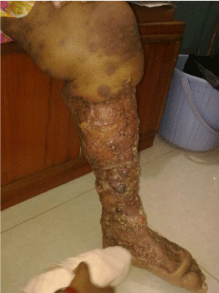
Clinical Image
Austin J Trauma Treat. 2016; 3(1): 1008.
The Complications of Surgical Treatment of Grade IV Filarial Lower Limb Lymphedema
Panda DK¹, Mohapatra DP²* and Mohapatra M³
¹Sanaria Laboratory, JIPMER, India
²Department of Plastic Surgery, JIPMER, India
³Department of Pulmonary Medicine, JIPMER, India
*Corresponding author: Mohapatra DP, Department of Plastic Surgery, Super Specialty Block, JIPMER, Pondicherry, India
Received: March 25, 2016; Accepted: March 30, 2016; Published: April 01, 2016
Clinical Image
A 55 year old female patient attends the OPD with a history of non healing ulcer over the left leg since last 6 months. She had been diagnosed as a case of filariasis of the lower limb stage IV and was subjected to debulking surgery with split skin grafting over the leg six months earlier. She has been complaining of frequent blistering over the grafted area and continuous serosanguinous oozing from the limb. She has been having frequent episodes of pain and fever. She appeared to be mentally distressed.
On examination her left lower limb showed a previously circumferentially split skin grafted area below the knee. There were multiple blisters and over the lower leg and foul smelling discharge. The cosmetic appearance of the limb was unappealing.
Discussion
Lymphatic filariasis is a neglected tropical disease caused most commonly due to infection with Wuchereria bancrofti which is a parasite transmitted into the blood stream by the bite of a female culex mosquito and subsequently passes in and affect the lymphatic system. Filariasis is associated with significant social and economic consequences for affected individuals, their families and community as a whole [1]. Elephantiasis refers to disfiguring swelling of the legs and genital organs often seen in late-stage disease. It may or may not be painful. Some authors prefer to address all stages of lymphatic filariasis as elephantiasis. According to estimates, 10 billion people in 55 countries worldwide remain threatened by lymphatic filariasis and require preventive chemotherapy to stop the spread of this parasitic infection [2,3].
Surgery for lymphedema has been advocated to reduce the weight of the lymphedematous region, minimize the frequency of infectious/ inflammatory episodes, and/or improve cosmesis and function. Several categories of surgical treatment have been proposed for the treatment of lymphedema: (1) excisional operations (e.g., debulking, amputation, and liposuction, (2) lymphatic reconstruction, and (3) tissue transfer procedures (e.g., lymph node transplantation, pedicled omentum, bone marrow stromal cell transplantation) [4].

Figure 1: Figure showing an operated limb with lymphatic filariasi with a
grotesque appearance and signs of inflammation.
While Lymphatic reconstruction and tissue transfer procedures can be done in earlier stages of Elephantiasis, debulking procedures and split skin grafting have been employed for late stages of elephantiasis. However debulking is associated with higher rates of complications as seen in our series. The complications range from breakdown of the skin graft, chronically nonhealing oozing wound, and repeated wound infections and in worse cases, Sepsis [5]. In our series one patient had to undergo above knee amputation of the lower limb as a life saving measure due to uncontrollable sepsis. Post excisional Cosmetic deformity is also a major concern in many individuals.
References
- Global programme to eliminate lymphatic filariasis: progress report, 2011. Wkly Epidemiol Rec. 2012; 87: 346-356.
- [No authors listed]. WHO still reeling from racism charges. AIDS Anal Afr. 1995; 5: 3.
- Addiss DG, Brady MA. Morbidity management in the Global Programme to Eliminate Lymphatic Filariasis: a review of the scientific literature. Filaria J. 2007; 6: 2.
- Cormier JN, Rourke L, Crosby M, Chang D, Armer J. The surgical treatment of lymphedema: a systematic review of the contemporary literature (2004- 2010). Ann Surg Oncol. 2012; 19: 642-651.
- Rao YG, Ananthakrishnan N, Pani SP, Kate V, Yuvaraj J, Krishnamoorthy K. Factors influencing response to lymphonodovenous shunt in filarial lymphoedema. Natl Med J India. 1999; 12: 55-58.